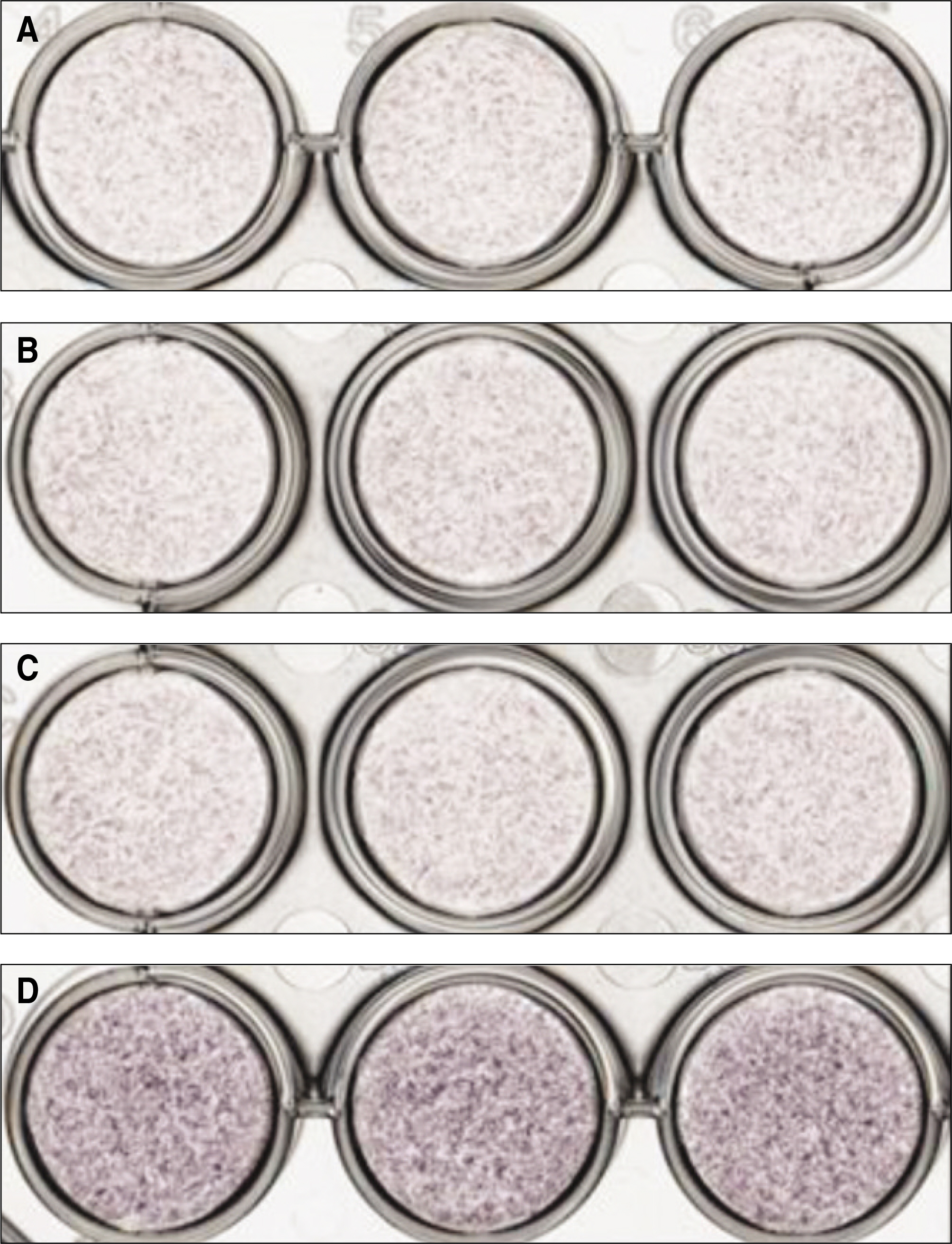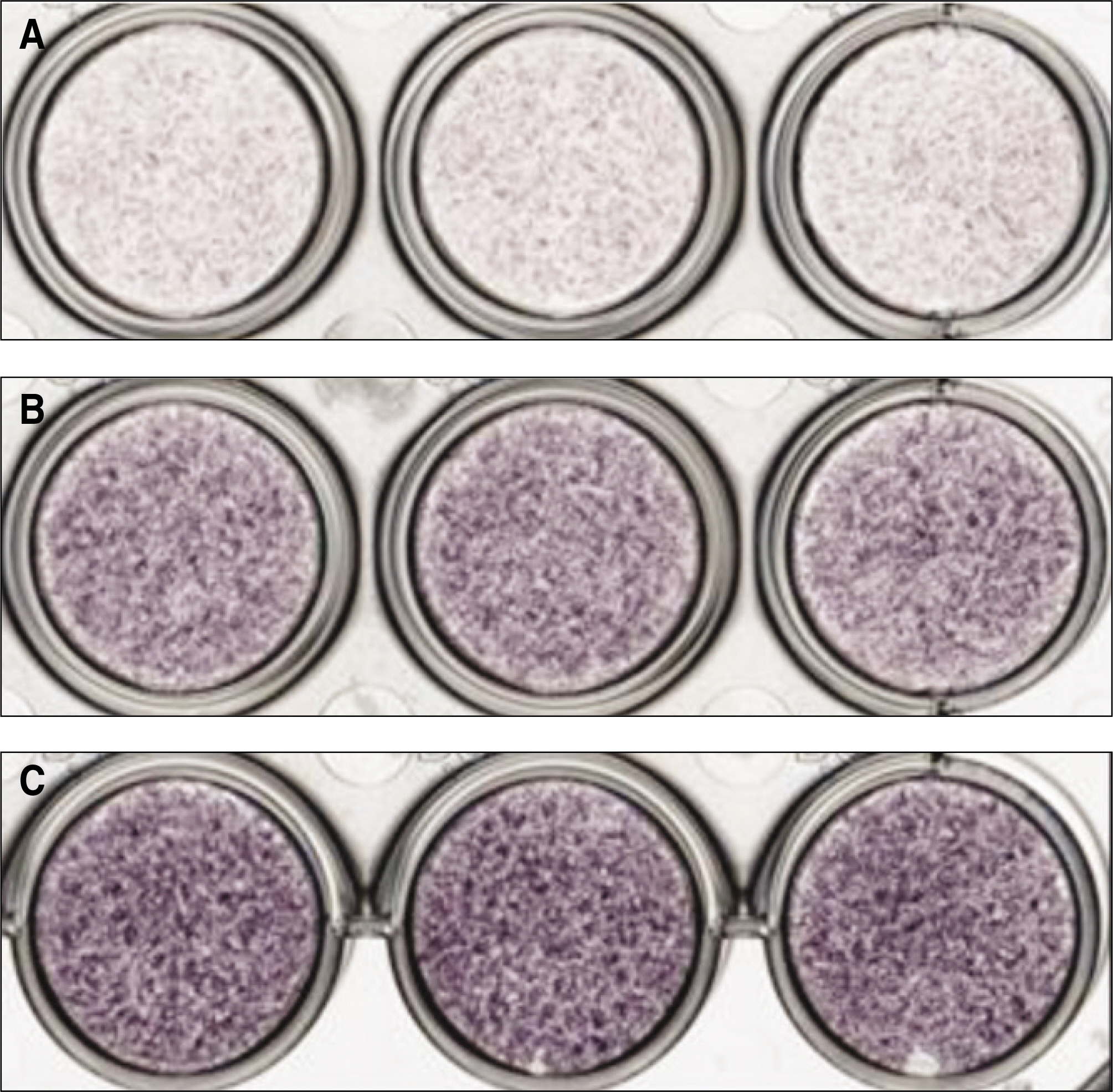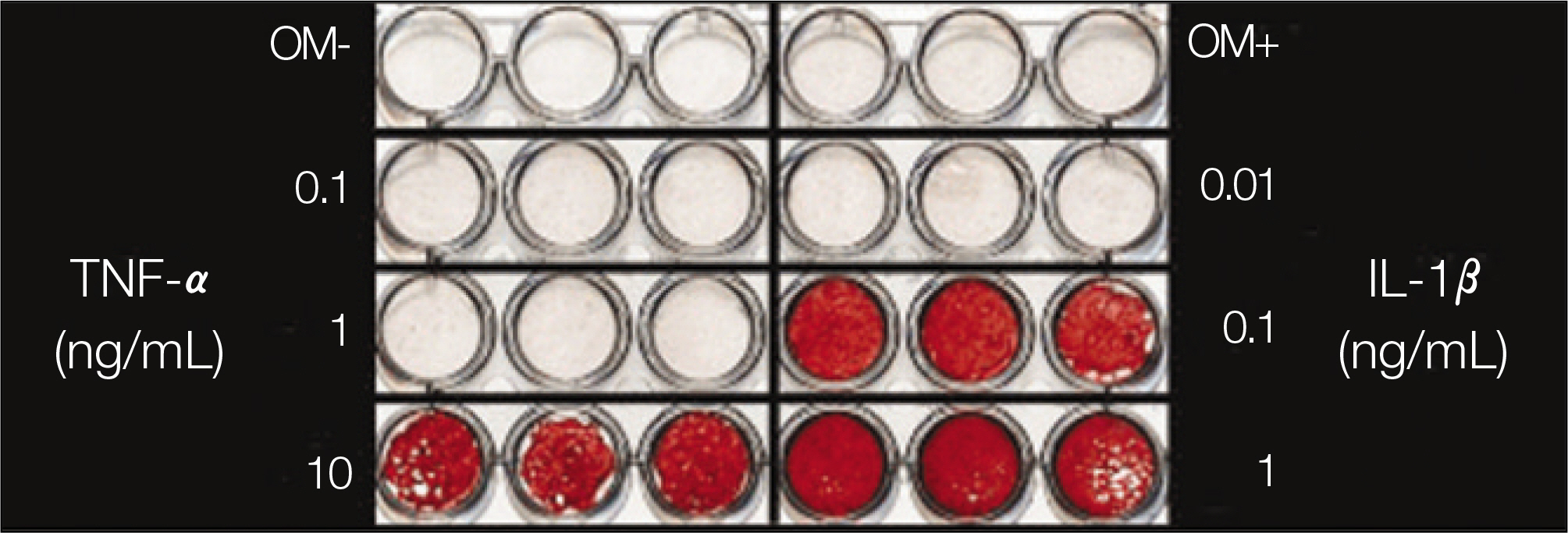J Korean Assoc Oral Maxillofac Surg.
2010 Oct;36(5):341-345.
Evaluation of osteogenic activity of periosteal-derived cells treated with inflammatory cytokines
- Affiliations
-
- 1Department of Oral and Maxillofacial Surgery, School of Medicine and Institute of Health Sciences, Gyeongsang National University, Jinju, Korea. surbyun@gsnu.ac.kr
- 2Biomedical center, Brain Korea 21 (BK21), Gyeongsang National University, Jinju, Korea.
- 3Clinical Research Institute, Gyeongsang National University Hospital, Jinju, Korea.
- 4Department of Biochemistry, School of Medicine and Institute of Health Sciences, Gyeongsang National University, Jinju, Korea.
- 5Department of Oral and Maxillofacial Surgery, School of Dentistry, Pusan National University, Yangsan, Korea.
- 6Maxillofacial Center, Onhospital, Busan, Korea.
Abstract
- INTRODUCTION
Skeletal homeostasis is normally maintained by the stability between bone formation by osteoblasts and bone resorption by osteoclasts. However, the correlation between the inflammatory reaction and osteoblastic differentiation of cultured osteoprogenitor cells has not been fully investigated. This study examined the effects of inflammatory cytokines on the osteoblastic differentiation of cultured human periosteal-derived cells.
MATERIALS AND METHODS
Periosteal-derived cells were obtained from the mandibular periosteum and introduced into the cell culture. After passage 3, the periosteal-derived cells were further cultured in an osteogenic induction Dulbecco's modified Eagle's medium (DMEM) medium containing dexamethasone, ascorbic acid, and beta-glycerophosphate. In this culture medium, tumor necrosis factor (TNF)-alpha with different concentrations (0.1, 1, and 10 ng/mL) or interleukin (IL)-1beta with different concentrations (0.01, 0.1, and 1 ng/mL) were added.
RESULTS
Both TNF-alpha and IL-1beta stimulated alkaline phosphatase (ALP) expression in the periosteal-derived cells. TNF-alpha and IL-1beta increased the level of ALP expression in a dose-dependent manner. Both TNF-alpha and IL-1beta also increased the level of alizarin red S staining in a dose-dependent manner during osteoblastic differentiation of cultured human periosteal-derived cells.
CONCLUSION
These results suggest that inflammatory cytokines TNF-alpha and IL-1beta can stimulate the osteoblastic activity of cultured human periosteal-derived cells.
Keyword
MeSH Terms
-
Alkaline Phosphatase
Anthraquinones
Ascorbic Acid
Bone Resorption
Cell Culture Techniques
Cytokines
Dexamethasone
Durapatite
Glycerophosphates
Homeostasis
Humans
Interleukins
Osteoblasts
Osteoclasts
Osteogenesis
Periosteum
Tumor Necrosis Factor-alpha
Alkaline Phosphatase
Anthraquinones
Ascorbic Acid
Cytokines
Dexamethasone
Durapatite
Glycerophosphates
Interleukins
Tumor Necrosis Factor-alpha
Figure
Reference
-
References
12. Park BW, Byun JH, Lee SG, Hah YS, Kim DR, Cho YC, et al. Evaluation of osteogenic activity and mineralization of cultured human periosteal-derived cells. J Korean Assoc Maxillofac Plast Reconstr Surg. 2006; 28:511–9.13. Park BW, Byun JH, Ryu YM, Hah YS, Kim DR, Cho YC, et al. Correlation between vascular endothelial growth factor signaling and mineralization during osteoblastic differentiation of cultured human periosteal-derived cells. J Korean Assoc Maxillofac Plast Reconstr Surg. 2007; 29:197–205.14. Walsh NC, Gravallese EM. Bone remodeling in rheumatic disease: a question of balance. Immunol Rev. 2010; 233:301–12.
Article15. Li YP, Stashenko P. Proinflammatory cytokines tumor necrosis factoralpha and IL-6, but not IL-1, downregulate the osteocalcin gene promoter. J Immunol. 1992; 148:788–94.16. Panagakos FS, Hinojosa LP, Kumar S. Formation and mineralization of extracellular matrix secreted by an immortal human osteoblastic cell line: modulation by tumor necrosis factoralpha. Inflammation. 1994; 18:267–84.
Article17. Nanes MS. Tumor necrosis factoralpha: molecular and cellular mechanisms in skeletal pathology. Gene. 2003; 321:1–15.18. Segal B, Rhodus NL, Patel K. Tumor necrosis factor (TNF) inhibitor therapy for rheumatoid arthritis. Oral Surg Oral Med Oral Pathol Oral Radiol Endod. 2008; 106:778–87.
Article19. Ji H, Pettit A, Ohmura K, Ortiz-Lopez A, Duchatelle V, Degott C, et al. Critical roles for interleukin 1 and tumor necrosis factor alpha in antibody-induced arthritis. J Exp Med. 2002; 196:77–85.20. Wei S, Kitaura H, Zhou P, Ross FP, Teitelbaum SL. IL-1 mediates TNF-induced osteoclastogenesis. J Clin Invest. 2005; 115:282–90.
Article21. Zwerina J, Redlich K, Polzer K, Joosten L, Kro¨nke G, Distler J. TNF-induced structural joint damage is mediated by IL-1. Proc Natl Acad Sci USA. 2007; 104:11742–7.
Article
- Full Text Links
- Actions
-
Cited
- CITED
-
- Close
- Share
- Similar articles
-
- Effect of dexamethasone concentrations on osteogenic activity of cultured human periosteal-derived cells
- STIMULATION OF OSTEOBLASTIC PHENOTYPES BY STRONTIUM IN PERIOSTEAL-DERIVED CELLS
- Evaluation of osteogenic activity and mineralization of cultured human periosteal-derived cells
- In Vitro and In Vivo Osteogenic Activity of Rabbit Periosteum and Periosteal Cells
- Osteogenic Activity of Cultured Human Periosteal-Derived Cells in a Three Dimensional Polydioxanone/pluronic F127 Scaffold





